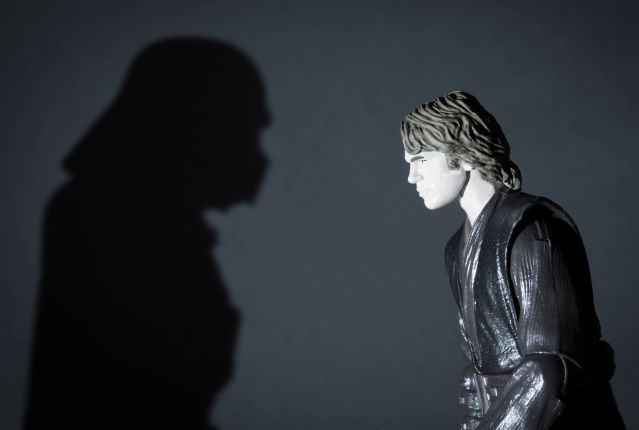Unconscious
The Shadow Self: How Mr. Hyde Operates in Us All
We all have a shadow self. What does yours look like?
Updated July 17, 2024 Reviewed by Jessica Schrader
Key points
- We all have a "shadow self," or a darker side, as first noted by the Swiss psychiatrist Carl Jung.
- The shadow aspect in us evinces itself in dichotomized psycho-intensive states of activation.
- Crude jokes, retaliatory jealousy, anger, and vengeful thoughts are just a few examples of the shadow in you.

You may have heard the term "shadow self" before. The idea of a shadow self has long roots in our history. As a child, I found some fascination with a fictional work by Robert Louis Stevenson entitled The Strange Case of Doctor Jekyll and Mr. Hyde. The idea therein is that good and evil reside in us all. And yet fiction may not be so far from the truth where threads of this storyline play out in modern-day culture routinely. From national headlines to therapy offices, the evidence of the shadow self can be heard in phrases like:
- "I wasn't myself."
- "They acted like someone possessed."
- "She seemed so different from the person I know.”
- “That's just not like me."
- "They seemed so nice"
There is also typically an accompanying sense of dissonance in all of these statements, and for good reason. In many ways, each of us embodies a bit of this "Jekyll and Hyde" phenomenon. In our everyday encounters, we may, on the surface, present a very pleasant personality for the most part, which is mostly who we are or want to be; however, emotional discontent with things like rage, jealousy, shame, lying, greed, envy, can give way to momentary "darker aspects" in us that are in stark contrast to who we believe we are or how others know us. I call this an activated form of“dichotomized psycho-intensity." In this, we may momentarily disenfranchise ourselves from the predominate "self" and plunge into the darker waters of our darker psyche. Some may also refer to it as a form of duality. In psychology, this is also known as the personal shadow which, like tales of the Wild West, is untamed and unchartered territory to many of us because we choose not to gaze into such an abyss, and for good reason (Abrams & Zweig, 1991).
We’ve all experienced moments where we may have felt quite "different" from who we are, momentarily apart, maybe even disembodied. In certain instances, some may recount such moments as though they were watching a different person "acting out." These experiences can be complicated for us to understand. Somewhere in your experience inventory, you have encountered situations that challenged you, where perhaps you were on the receiving end of some kind of disrespect, hurt, or made to feel a certain way. In that experience you may have also felt the presence of another aspect in you rising, an internal voice becoming agitated, critically and emotionally charged, and more internally vocal as it met that experience. Consequently, maybe your reaction evinced an outburst of anger, a retaliatory jealous reaction, a denigrating or heavy-handed criticism of another, or in vengeful thoughts, a crude joke, or other passive-aggressive reactions. What showed up was the shadow self.
What Is the Shadow Self?

This concept of the "shadow self" was introduced into our vernacular by Swiss psychiatrist Carl Jung. His perspective, however, may have taken inspiration from Austrian Neurologist Sigmund Freud, who had explored this aspect of the unconscious mind and used words like shadow, melancholia, and projection to depict how people might act on repressed issues (Coolidge, 2023). In Jung's disposition, he believed the shadow aspect of our self as “a thing a person has no wish to be" (Perry, 2015). He also described it as the part of our psyche containing the hidden aspects of our personality that we reject or hide from others, even ourselves. These hidden aspects often include our impulses, desires, and personal qualities that society may deem socially negative or unacceptable (Jung, 1953). Essentially then, the shadow-self is considered by many to be the darker, looming side of our personality that we are less willing to engage or recognize (Lonngi, 2024).
In this, the shadow aspect is a construct built from many things such as the unhealed hurts of negative experiences to the repressed desires we may hold at bay. It is part of the unconscious mind that is complementary to the ego, where conscious processing of self may refuse such shadowy aspects through suppression and repression processes, sending all things we would rather not acknowledge to the back, burying them deep, only to see these shadowy potentials show up as awkward confrontations when triggered by others around us. Ignoring the shadow only emboldens this underdeveloped aspect in us, strengthening it in unhealthy ways.
How Can We See the Shadow Operating Within Us?
Because the shadow aspect resides at an unconscious level, we can never truly observe it directly. We cannot reference the unconscious mind via the conscious so easily, just as the sun and moon are distinct from one another, one never effacing the other, so it is with the unconscious and conscious mind. But, this doesn't mean we cannot know of them, or learn from their phases. To observe the shadow at work, we must learn to see it indirectly, or in the periphery of our thoughts, behaviors, and actions as the shadow self comes to fruition in the following ways:
- Repression: This is an unconscious process where undesirable thoughts and feelings are pushed out of our conscious awareness. For example, a person might repress feelings of jealousy because they believe it’s a negative emotion (Johnson, 1991).
- Suppression: Unlike repression, suppression is a conscious effort to avoid thinking about disturbing thoughts. This might involve pushing away feelings of sadness or anger to maintain a facade of happiness.
- Projection: This is one of the prominent ways to catch the shadow at work. It occurs when we attribute our own unacceptable qualities or feelings to other people. family/groups. For example, if someone has repressed feelings of anger, they might perceive others as being angry or hostile, even when there’s no real evidence, simply because they are angry. This mechanism allows us to deny our own flaws by seeing them in others (Ford, 2010). In other words, what I dislike about others is something I struggle with in "myself." You can see this mechanism play out in Reddit groups and other social media daily.
- Triggers and Emotional Reactions: Situations or people may evoke strong emotional reactions in us that often touch on our shadowy aspects. If you find yourself having an exaggerated emotional response to a minor event, it might be a sign that your shadow self is coming forward. These triggers can be valuable clues, helping us identify parts of ourselves that need attention and healing (Zweig & Abrams, 1991).
- Dreams and Fantasies: The shadow often manifests in dreams and fantasies, where the unconscious mind has free rein. These hidden aspects of our personality often appear in symbolic form during sleep (Jung, 1953).
- Behavioral Patterns: The shadow can subtly influence our behavior through habits, compulsions, and automatic responses. For instance, someone with a "repressed desire for control" might exhibit passive-aggressive behaviors as a way to indirectly assert dominance (Ford, 2010).
- Hypercritical Activation: The shadow can be seen when we are extremely critical of others, how they live, what they do, how they behave, etc. It can manifest in feelings of fervent anger, jealousy, and critique about a person or group, and manifest in hyperpolarized views about the world.
Modern thinking about this psychological phenomenon of the shadow self suggests that we should not run from it, but rather, try and understand it, meet it, and teach it, so that we may rebalance conscious perspective with the unconscious realm.
In Part 2 of this series entitled "The Shadow Self: Learning How to Engage Your Darker Side," we will look at a few healthy ways to meet the shadow aspect in us.
References
Abrams, J., & Zweig, C. (1991). Meeting the shadow : the hidden power of the dark side of human nature. http://ci.nii.ac.jp/ncid/BA25894106
Coolidge, F. L. (2023). Pandemic sleep and dreams. Elsevier EBooks, 177–183. https://doi.org/10.1016/b978-0-323-88494-5.00011-3
Ford, D. (2010). The Dark Side of the Light Chasers: Reclaiming Your Power, Creativity, Brilliance, and Dreams. Riverhead Books.
Johnson, R. A. (1991). Owning Your Own Shadow: Understanding the Dark Side of the Psyche. HarperOne.
Jung, C. G. (1953). Collected Works of C.G. Jung, Volume 9 (Part 2): Aion: Researches into the Phenomenology of the Self. Princeton University Press.
Lonngi, G. (2024). The Jungian Shadow and Self-Acceptance. Tamug.edu. https://www.tamug.edu/nautilus/articles/The%20Jungian%20Shadow%20and%20…
Perry, C. (2015, August 12). The Jungian Shadow. Society of Analytical Psychology. https://www.thesap.org.uk/articles-on-jungian-psychology-2/about-analys…


